| Lab
Managers, Employees Engage in Lively Dialogue
Lab Managers, Employees Engage in Lively DialogueBy Ron Kolb The questions were about site security, energy conservation, Laboratory audits, utility surveying, scientific engineering, departmental peer reviews, and program burdens. The subjects and interests were as diverse as the portfolio of tasks that the audience represented. But all who gathered for the first “brown bag” conversation with the Lab’s executive leadership seemed unified on one thing — that this unprecedented dialogue was well worth the time. The preliminary results of what Director Charles Shank described as an “experiment” were encouraging indeed. About 50 employees gathered in Perseverance Hall on March 25 to chat with Shank and his chief deputies, Sally Benson of Operations and Pier Oddone of Research. Between bites of sandwiches and sips of soda, the managers fielded a variety of questions and comments while sharing information on Lab priorities and challenges. “We have been looking for new ways to communicate with people,” Shank told his fellow lunchers. “One idea is an informal way to get together, like today. We’re going to try it, to see if people will feel better informed about the lab.” Benson said the brown bag session was partly an outgrowth of feedback she received in “listening forums” held with staff around the Lab last fall. “Across the board, we heard that people wanted more two-way communication with senior leadership of the Lab. If this works, we’ll be doing more of these. If not, we’ll try something else.” Indications are that future brown bags will be scheduled, because those in attendance gave the trio a warm ovation at the end of the hour-long discussion. Shank thanked them for “this time to interact.” The Director opened the session with a few updates on timely issues — negotiations on the UC management contract for Berkeley Lab are being delayed until the Los Alamos contract issue is settled; Laboratory funding as proposed by the Bush Administration for FY04 appears to be “reasonable;” and the unfortunate DOE proposal to close the 40-year-old 88-inch cyclotron presents clean-up cost concerns not unlike those now seen at the decommissioned Bevatron. On the issue of Lab security during wartime, Benson noted that her staff has developed several scenarios under which gate security might tighten or, most seriously, if employees need to be offered optional vacation leave. In all cases, people on site will be informed via public address announcements and notices on the Lab’s emergency “800” number.
Benson talked a bit about energy efficiency measures that continue at Berkeley Lab, and Shank commented on the problems at Los Alamos. Joe Walling of Facilities then told the managers about the importance of underground surveying for utilities, and his concern that staffing in that area was insufficient to ensure safety, especially in light of future building plans. Benson assured him that she and Facilities Division Director George Reyes would look into it. Roberto La Mantilla of Engineering inquired about coming projects in which mechanical engineers might play a role. Oddone ran through a list of promising scientific initiatives that include the SuperNova/Acceleration Probe (SNAP) in physics, the Molecular Foundry nanoscience building, Genomes-to-Life and related microscopy, high-speed computing, and perhaps inertial confinement fusion. “Our (engineering) work is driven by scientific projects, so there are peaks and valleys,” Oddone said. “It’s difficult to manage. In a couple of years, there is some real promise (for more activity).” Benson also addressed a question on Pro-card and other audits here that are following the Los Alamos investigation of financial mismanagement. She expressed thanks to those who are devoting additional time to the reviews. “We haven’t found an instance of theft or fraud. You are our vanguard for allowing us to have a Laboratory here.” A new purchasing system and possible distribution changes should be announced by the end of April, she added. Marty Baron of Facilities asked about the peer review process for departments, and architect Nick Peterson expressed concern about the lab-wide confusion surrounding budget burdens and what they fund. Benson promised to address issues like this in a forthcoming “clear up the confusion” information campaign. Study Finds New Branch on Tree of LifeBy Lynn Yarris Berkeley Lab resear-chers, working with a team of Italian researchers, have discovered a new branch on the family tree of life and showed that there’s more than one way to evolve six legs.
Genetic studies comparing mitochondrial DNA have revealed that what has long been thought to be the ancestors of all insects — a wingless group of hexapods known as the Collembola or springtails — aren’t closely related to insects after all. Instead, these creatures belong to a separate evolutionary lineage that predates even the separation of insects and crustaceans. The research was carried out at the Joint Genome Institute (JGI) and reported in the March 21 issue of Science. “Based on the similarities in their body organization, their six legs and other morphological characteristics, it has been generally accepted that the collembolans were the basal stock from which insects arose,” says Jeffrey Boore, a biologist with Berkeley Lab’s Genomics Division who heads JGI’s Evolutionary Genomics Department. “Our study shows that they evolved separately from insects and independently adapted to life on land.” Collaborating with Boore on the project were Francesco Nardi, Giacomo Spinsanti, Antonio Carapelli, Romano Dallai and Francesco Frati, all with the Department of Evolutionary Biology at the University of Siena in Italy. “The collembolans appear to branch off the evolutionary line leading to the insects at a much earlier stage than previously thought, earlier than some if not all of the crustaceans,” says Nardi. “In fact, the few crustaceans that we’ve analyzed so far using mitochondrial genomics appear to be more closely related to the true insects than are the collembolans.” Mitochondria are organelles, found in living cells, that play a central role in vital life processes such as metabolism. They have been called “the powerhouses” of cells because they produce the ATP molecules that provide cells with chemical energy. But mitochondria were actually once independent organisms that long ago evolved into a symbiotic relationship with cell nuclei. The former independence of mitochondria has been preserved in a tiny genome, separate from the genome of the host cell, with its own genes and its own system for DNA replication and translation into proteins. Much simpler than nuclear genomes, but governed by the same rules of genetic conservation and closely interacting with host cell genomes, mitochondrial genomes can serve as a powerful tool for the study of evolutionary biology. “The small size and compact arrangement of mitochondrial genomes make it possible to study and do comparative genomics with many different organisms,” Boore says. “Plus, these genomes are usually circular, which allows them to be physically isolated from nuclear genomes and their biochemistry is relatively well understood.”
Insects have been thought to be the dominant group of the Hexapoda, which also has been thought to include the Collembola and a few other wingless groups. Together they have been included as part of the phylum Arthropoda which constitutes nearly 85 percent of all known species of animal life. Other arthropod taxa (the name means “jointed feet”) include Myriapoda (for example, centipedes and millipedes), Chelicerata (for example, spiders), and Crustacea (for example, crabs and lobsters). Using classic approaches to evolutionary biology such as comparative morphology or paleontology, it has long been held that Hexapoda is a “monophyletic” taxon, meaning all members of the group are descended from a single ancestor. However, by doing comparative analyses of the DNA from entire mitochondrial genomes, Boore and Nardi and their collaborators found that Collembola should not be included within Hexapoda. “Based on our results and consequent phylogenetic reconstruction we can say that collembolans, which have until now been classified as the sister group to the insects within the hexapods, should be separated so that they constitute a separate evolutionary line,” says Nardi. “The next step will be to assign a class level status to Collembola, but this decision probably won’t be made on the basis of a single study even if the results we present seem to be quite strong.” The JGI is a collaboration between Berkeley Lab, Lawrence Livermore, and Los Alamos National Laboratories, and is funded by DOE’s Office of Biological and Environmental Research. At its headquarters in Walnut Creek, Calif., is housed one of the nation’s fastest and most powerful genome sequencing operations. Nardi says he and his Italian collaborators sought out Boore to work on this project because they consider him the “world’s leading expert” in the study of mitochondrial genomics. “Jeff provides his expertise on mitochondrial genomics and is a bridge” between us and the huge sequencing and technical capabilities of the JGI,” Nardi says. “This has been a very fruitful collaboration so far, and we are planning to do more studies along this line.” Genomics Celebrates Big Landmarks in AprilBy Charles Osolin Two of the most important landmarks in the history of biological research are being celebrated this month: the completion this year of the human genome sequence, and James Watson and Francis Crick’s Nobel Prize-winning description of the DNA double helix 50 years ago. On April 14, the U.S. Department of Energy (DOE) and the National Institutes of Health (NIH) will hold a news conference to announce the completion of the Human Genome Project — an international, $3 billion effort begun in 1990 to determine the complete sequence of the three billion DNA base pairs in the human genome. The news conference will also describe the federal government’s vision for the future of genomics research and highlight DOE’s “Genomes to Life” program.
The DOE Joint Genome Institute (JGI) in Walnut Creek, a consortium formed by Lawrence Berkeley, Lawrence Livermore, and Los Alamos national laboratories, played a key role in the Human Genome Project by sequencing chromosomes 5, 16 and 19. JGI Director Eddy Rubin, who also serves as director of LBNL’s Genomics Division, will participate in a scientific symposium entitled “From Double Helix to Human Sequence and Beyond,” to be held April 14 and 15 at NIH headquarters in Bethesda, MD. In addition, the JGI is holding an informal, by-invitation Open House for area elected and education officials on the morning of April 14. Visitors will be able to watch the DOE/ NIH news conference, hear a briefing about the JGI’s role in the human genome project and its future as a leading genome sequencing and biological research center, and tour the JGI’s state-of-the-art sequencing facilities. More information about genome-related activities this
month can be found at New Diversity Council Holds Its First Meeting
Limited Flexible Work Options Pilot BeginsA limited pilot program designed to evaluate the effectiveness of flexible work options for employees at Berkeley Lab will be conducted with a total of 50 participants. Program participants will be selected in work units located in EH&S, NERSC and ITSD beginning May 1. The pilot program will be restricted to the 9/80 option. The decision to launch the pilot with a limited number of participants will enable the Lab to ensure program objectives can be met before determining how to expand the program. Deputy Director for Operations Sally Benson made the announcement, noting that a six month assessment is required before considering offering the program to a broader laboratory community. An external organization, Merit Resources Inc., is being engaged to validate and audit program design, and ensure policy and managerial controls are in place. Four Lab Technologies Nominated for
R&D
|
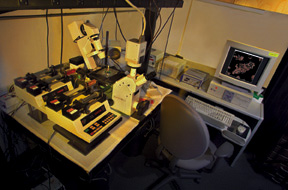 VSOM equipment: pumping station on far left, microscope center, and computer running VSOM software on the right. |
VISTA has become one of the most popular and widely praised comparative genomics tools. Through March 2003, more than 2,000 researchers from 38 countries have used the system, submitting more than 25,000 DNA sequences to the VISTA website for analysis. More than 1,000 academic research licenses have been granted to scientists in 45 countries, and seven commercial use licenses have been sold.
• Visual Servoing Optical Microscopy (VSOM™) combines the power of computers and quantitative analysis with fluorescence microscopy for use in assays and drug discovery. It uses real-time feedback from the cells under study to adapt the pace of an experiment, and stores data to guide future experiments. This process allows researchers to create optimal conditions for the experiment on the first try, saving materials costs and accelerating the pace of research. The technology has been licensed to VSOM™ Inc.
• EnergyPlus Software for Designing Energy Efficient Buildings: EnergyPlus is a software program for conducting building energy simulations. It is used by architects and designers to optimize building energy efficiency and occupant comfort. The software models different scenarios in which the lighting, heating and cooling systems, and window placement may be varied to determine which permutation produces the most energy efficient building, while providing occupant comfort and meeting costs.
EnergyPlus has attracted over 12,000 downloads, 50 collaborative developer licenses, and eight distribution licenses. It has been used around the world to design airports, hospitals, schools, and commercial spaces. It is currently being used to study the energy efficiency of plans for rebuilding the World Trade Center.
Published twice a month by the Communications Department for the employees and retirees of Ernest Orlando Lawrence Berkeley National Laboratory.
Ron Kolb, Communications Department head.
EDITOR: Monica Friedlander, (510) 495-2248, msfriedlander@lbl.gov
STAFF WRITERS: Lisa Gonzales, 486-4698; Dan Krotz, 486-4109, Paul Preuss, 486-6249; Lynn Yarris, 486-5375
CONTRIBUTING WRITERS: Jon Bashor, X5849; Allan Chen, X4210
FLEA MARKET / CALENDAR: 486-5771
fleamarket@lbl.gov /currents_calendar@lbl.gov
Lawrence Berkeley National Laboratory,
Communications Department, MS 65
One Cyclotron Road, Berkeley CA 94720
Tel: (510) 486-5771 Fax: (510) 486-6641
Berkeley Lab is managed by the University of California for the U.S. Department of Energy.
Deputy Director for Operations Sally Benson has named Jane Baynes as associate for operations, the chief staff position for Operations.
Baynes, who has been at Berkeley Lab for six years, has primarily served as a manager in the Workforce Diversity Office and as consultant in Employee and Labor Relations.
Her new role will include supporting the deputy director and her staff, tracking progress on the Operations Strategic Plan, special projects, and serving as liaison with the Operations Leadership Team.
By Paul Preuss
Diatomite, made from countless silica skeletons of microscopic aquatic plants, is up to 70 percent empty space. Found in important oil-bearing formations, diatomite is fragile and light enough to float on water — but so nearly impermeable that it’s hard to get the oil out. In fact, no one is quite sure how the oil got into it in the first place.
Now scientists and engineers from Berkeley Lab, UC Berkeley, and the ChevronTexaco Corporation are finding better ways to tap this rich but miserly mineral.
Starting small
Tad Patzek and Dmitry Silin of the Earth Sciences Division (ESD), working with Guodong Jim of UC Berkeley, have used computer modeling to study how sediments become rocks in the first place.
They begin with a randomly distributed collection of grains, idealized as spheres of different sizes. After compacting, the process by which the grains become cemented together is modeled. The model produces astonishingly realistic simulated rocks; its reconstruction of sandstone is virtually indistinguishable from real sandstone imaged by synchrotron X-ray tomography at micron scale (millionths of a meter).
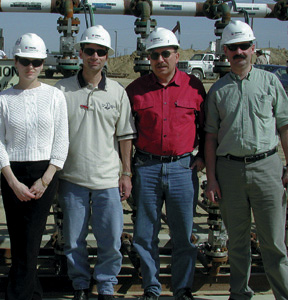 A Berkeley Lab and ChevronTexaco team designed and installed automatic injection equipment to maintain the right water pressure in the Lost Hills diatomite. From left, Monika Valjak, ChevronTexaco field engineer; Jim Brink, ChevronTexaco field advisor; Tad Patzek and Dmitry Silin of ESD. |
Computer reconstruction may make it possible to understand the mechanical properties of any kind of sedimentary rock — even diatomite. Until then, to adequately characterize the pore structure of reservoir diatomite, what’s needed are images at nanometer scale (billionths of a meter).
The challenge is being met by ESD’s Liviu Tomutsa and Velimir Radmilovic of the National Center for Electron Microscopy (NCEM) in the Materials Sciences Division. Transmission electron microscopy typically requires samples only a few microns thick. No mechanical slicing or polishing technique can operate on so fine a scale without tearing the sample to shreds; for some time NCEM has prepared samples using ion-beam milling.
Sweeping across a sample, a beam of gallium ions mills it nearly perfectly flat, sputtering off patches of atoms a few dozen at a time. Secondary ions are freed and can be focused into a high-contrast image of the surface.
“As the beam shaves off layers of material only a few nanometers thick, it simultaneously makes a stack of 2-D images,” says Tomutsa. “These can be stored in a computer and combined into a 3-D picture that reveals the constrictions and connectivity of the pores, the factors that affect trapping of liquids.”
When these tomographic images are complete, says Tomutsa, they will be “the first-ever images of diatomaceous rock in 3-D.” What’s more, he says, by using the ion beam to mill and image samples at very low temperatures, “we’ll actually be able to see the oil inside the rock, undisturbed, frozen in the pores.”
Oil and water
Energy companies can’t wait for a fundamental understanding of rocks before drilling for oil. Billions of barrels lie in the diatomite formations of the Lost Hills and Belridge oilfields in central California, discovered in 1910. Yet after a century of technological development, it’s estimated that less than ten percent of it can be extracted.
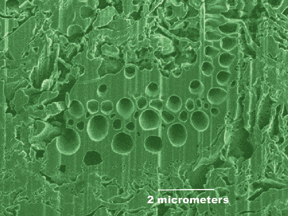 A beam of gallium ions shaves off a sample of diatomite layer by layer, imaging each layer. A computer will combine the succeeding images to reconstruct the rock in three dimensions. |
There was virtually no production from the Lost Hills Field until 30 years ago, notes ESD’s Patzek, who is also a professor of civil and environmental engineering at UC Berkeley. Then, by using hydrofracturing — breaking the rock with pressurized water — production was increased to its current level of some 10,000 barrels of oil a day.
One result was that parts of the oil field began to collapse and subside. In 1992 ChevronTexaco introduced a program of balanced waterflooding in the Lost Hills Field, hoping to reduce subsidence and increase oil recovery.
Water injected into an oil-bearing formation under pressure is supposed to do several things: fracture the rock to release the oil, push it into flow-conducting fractures, and fill the voids to maintain pressure and structural integrity. Despite careful planning and monitoring, waterflooding at Lost Hills has done less than expected to stop subsidence. The ground continues to sink over wide areas, shearing off well casings.
Part of the reason is that the diatomite beds are divided into segments by vertical faults and horizontal strata. Layers vary from less than a millimeter to tens of meters thick. Excessive water-pressure causes weakly bound layers to break apart; channels open, and water can flow directly from injection well to production well without moving any oil.
To prevent this, injection pressures must be monitored and adjusted at frequent intervals. Working with colleagues at ChevronTexaco, including Jim Brink and Pat Perry, Patzek and Silin have developed the internet-based Supervisory Control and Data Acquisition (SCADA) system.
Their work was inspired by a new concept of damage propagation in diatomite, involving consequent modification of rock properties, proposed by Grigory I. Barenblatt, a professor of mathematics at UC Berkeley and a member of Berkeley Lab’s Computing Sciences Directorate. Early results are encouraging. Since February, 2002, SCADA has analyzed data from pressure and flow-meter readings from wells at Lost Hills and used it to automatically control 12 water injectors in real time.
“You can’t produce from diatomite without injection,” Patzek says, “but we’ve got to learn how to control the process.”
When the day comes that computer modeling and real imaging converge to reveal the structures of rocks on the finest scale, both theoretically and experimentally, energy companies may be able to choose the best techniques for extracting oil from tough formations — without the expensive trial and error that characterizes oil recovery today.
More about diatomite and new technologies for oil recovery can be found in the April Science Beat at http://enews.lbl.gov/.
Diatoms: (from the Greek for “cut apart”): microscopic, single-celled plants with two parts, including various algae and plankton, whose cell walls are secreted from silica. Diatoms occur in numerous intricate forms; their skeletons constitute diatomite and the diatomaceous earth used to filter water.
Ions: particles with net electrical charge, usually atoms or molecules with one or more additional electrons (negative ion) or lacking electrons (positive ion). Being charged, they can be steered and accelerated with electric and magnetic fields.
Tomography: (from the Greek for “writing with slices”): building an image by combining images or ray-paths. For example, a Computerized Axial Tomography (CAT) scan can combine 2-D x-ray images to build 3-D images of parts of the body, and seismic tomography can combine earthquake waves to form images of the inner earth.
By Jim Miller
On April 17, upgrade work will be completed at the Grizzly Substation, further enhancing the Lab’s recently upgraded 12-kV electrical supply system. The $6 million project began in 2000, following completion of UC Berkeley’s Hill Area Substation, which has supplied electricity to Berkeley Lab while construction was in progress.
Located on Glaser Road near Building 77, Grizzly Sub’s high-voltage lines, towers, transformers and switchgear supply electricity to the entire Berkeley Lab site. Two banks of transformers receive power from PG&E’s 115-kV transmission lines, step it down to 12 kV, and distribute it through multiple 12-kV feeders to a number of switching stations. Grizzly Substation also feeds cogenerated power from UC’s central steam heating plant to the PG&E grid.
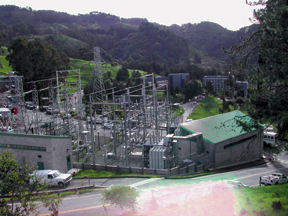 The recently upgraded Grizzly Substation on Glaser Road will provide Berkeley Lab wth less costly electricity and other benefits. |
This upgrade came as a result of UC’s decision in 1993 to purchase Grizzly Substation from PG&E. By owning the substation, the University can purchase power from PG&E at 115-kV transmission line rates, instead of the much higher “primary” rates charged on the 12-kV side of the transformers. It was an opportunity the University couldn’t pass up: the energy cost savings would yield a payback of about two years on the purchase of the substation.
Aside from the saving on its electric bill, the University had big plans to revamp the station — doubling its capacity from 50 MVA to 100 MVA — to handle projected demand on the UC Berkeley campus. Although Berkeley Lab stood to benefit from better electrical rates, the University’s planned upgrades had the potential to limit the Lab’s flexibility, especially in hooking up equipment that has pulsing power. After extensive negotiations between DOE, Berkeley Lab, and UC Berkeley Regents, a win-win agreement emerged in 1995: UC would build the Hill Area substation, upgrade Grizzly (at DOE’s expense), and then deed Grizzly to DOE.
With all the work completed, the 12-kV system is now more reliable than ever, with Grizzly and Hill Area stations providing backup for each other. The improvements to the Grizzly Substation, which was built in the 1950s, include replacement of Transformer Bank 1, as well as construction of improved oil spill containment facilities, installation of new controls and a control shelter, installation of 115 kV metering facilities, addition of a 115 kV tie-breaker circuit breaker, construction of grounding system improvements, and incidental repairs to existing structures.
As sole user of Grizzly Sub, Berkeley Lab will benefit in a number of ways. For example, there will not be a need in the future to negotiate how much power will be assigned to the Laboratroy, and we will be free to resolve quality issues ourselves. Additional benefits will include lower maintenance and operating costs than those associated with third party ownership, and lower energy costs.
With a total capacity of about 60 MVA, the Grizzly Substation has enough electrical capacity to supply a small city. That’s enough power to meet Berkeley Lab’s energy needs well into the century.
This high capacity and reliability promises stable, reliable power for the Laboratory’s current programs, as well as a ready, flexible power supply for the future.
By Dan Krotz
Every few days, retired Berkeley Lab nuclear engineer Al Smith stops by the City of Berkeley’s Public Works Department and picks up an armful of air filters that were dispersed throughout the city. He then analyzes the filters for telltale signs of radioactive substances using a high-purity germanium radiation detector.
He’s looking for cobalt and cesium isotopes, which, if detected, would indicate that harmful radiation has been released somewhere in the Bay Area. His work may provide the earliest indication of the epicenter and scope of a terrorist attack. It could also provide key details concerning contaminated areas that must be evacuated, and safe havens where people could seek refuge
Sounds like an expensive operation, but it’s not. The air filters, which come from police cars, are free. And Smith, who used to work in Environment, Health and Safety, now volunteers his time. He’s happy to report that so far there’s nothing to report.
“We have not seen any red flags, only natural background,” Smith says.
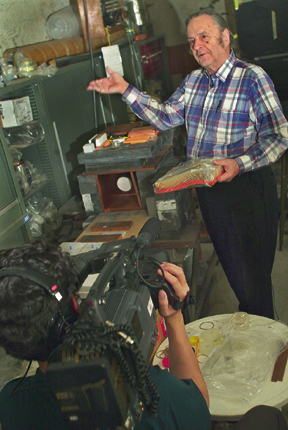 Nuclear engineer Al Smith |
Smith’s idea to use air filters to monitor for airborne radiation dates back to 1986, when the Chernobyl disaster spewed a radioactive cloud into the atmosphere. He and colleagues set up a sampling station at the Lab’s firehouse to test for the cloud. The first nucleotides appeared about two weeks after the accident, representing a round-the-world journey the radioactive cloud would make four more times.
“When the nucleotides arrived, it occurred to me to also examine a car filter. And sure enough, there they were,” Smith said. “So I made a mental note that we could see nucleotides using car air filters.”
Fifteen years later — and a few weeks after September 11 — he again thought of air filters. Perhaps they could monitor the air for the signs of a dirty bomb or terrorist-related radiation release. In order for this to work, however, he needed a steady supply of several filters each week. Fortunately, Gordon Wozniak, a Berkeley City council member and a former Berkeley Lab physicist, arranged for Smith to obtain filters from the Public Works Department, which maintains the city’s police cruisers.
As Smith explained, Berkeley’s police cars were chosen for several reasons: Berkeley is an urban area downwind of San Francisco. And police cars have regular routes, are in constant use, and have a routine maintenance schedule — meaning in the event of an attack, it’s possible to quickly determine which areas have been affected by radiation, and which have not.
“We wanted to get this system in place as quickly as possible,” Smith said. “The samplers are deployed at no cost, and we’ve checked about 300 a year since January of 2002.”
In addition, the filters are highly sensitive, able to capture very low concentrations of beryllium 7, a naturally occurring nucleotide formed by cosmic rays.
As for Smith, he’s more than happy to contribute his time to help safeguard the community.
“Over the last 50 years, the public has paid me to work at the Lab with the most advanced equipment,” Smith said. “This is an opportunity to give back for this privilege.”
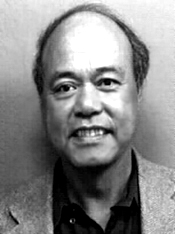 |
When the Audit Services Department got together this week to summarize how their former colleague, El Reyes, should be remembered, their only problem was expressing the warm memories. “We have so much to say about El, but it’s hard to put those thoughts into words,” said audit specialist Edna Kolandaisamy.
Reyes, 59, audit group leader in Internal Audit Services, died on Monday after losing his battle against cancer. He was the first member of the newly established internal audit department when he came to Berkeley Lab from Livermore in 1992. Since then, he formed strong personal bonds throughout the Lab while contributing significantly to developing systems, controls and audit management practices.
To those who knew him best, he was a loving family man … a native of the Philippines who arrived in America with his wife, one suitcase and a CPA certificate … a golf enthusiast whose recently purchased home on a Las Vegas golf course was his retirement dream … an active church goer and long-time school board member … and a great dancer.
To his boss, audit manager Terry Hamilton, he was that — and so much more.
“It won’t be the same around here without him,” Hamilton said. “His detailed knowledge of the Lab’s history made him a very valuable resource. He never declined a request to help, and was always ready to contribute. His enduring energy and work ethic will always be remembered.”
Among Reyes’ most notable accomplishments was receipt of an Outstanding Performance Award in 1995.
He also pioneered the methodology used in many of the Lab’s audits.
Meredith Montgomery, audit group leader recalled, “One of El’s proudest moments was being sworn in as a U.S. citizen in the Ceremonial Courtroom in San Francisco during America’s bicentennial in 1976.”
“El’s loyalty and dedication was devoted to making the Lab a better place,” Hamilton said. “He will be greatly missed.”
Elpidio M. Reyes leaves his wife, Evelyn, daughters Denise and Diane, son David, and son in law Daniel. A viewing is scheduled for Sunday from 1 to 9 p.m. and Monday from 9 a.m. to 9 p.m. at Colonial Chapels, 1000 Redwood Street, Vallejo. A funeral mass will be held Tuesday at 11 a.m. at St. Vincent’s Catholic Church, 925 Sacramento Street, Vallejo, followed by burial at All Souls Cemetery. Flowers and donations may be sent to Evelyn Reyes, 106 Picadilly Circle, Vallejo, 94591.
Nobel laureate Samuel C.C. Ting (third from the left) visited Berkeley Lab on March 26 to speak at a Nuclear Science Division colloquium. His topic was the alpha magnetic spectrometer experiment on the international space station. He is shown here after a luncheon with postdocs from Berkeley Lab.
Left to right are: Eugene Yamamoto, Bruce Berger, Professor Ting, Mrs. Ting, Jennifer Klay, Alan Poon, and Kai Schweda.
Ting was the corecipient of the 1976 Nobel Prize in physics for his pioneering work in the discovery of a new heavy elementary particle. In 1977, he was the first recipient of the Thomas Dudley Cabot Institute Professorship at MIT, where he remains today.
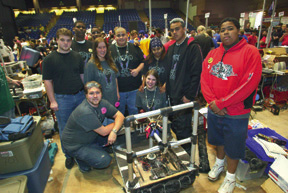 |
A dedicated team of Castlemont High School students, working with members of the Lab's Engineering Division, are on their way to Houston next week to compete in the National Robotics Competition.
The team, mentored by Paul Harris (left front) and Deb Hopkins (standing, second row left) finished in third place in the regional robotics competition held last week in San Jose, which qualified them for the national event.
"These are great kids, who are excited about being involved in science and math and engineering," Harris said.
But the hard work isn't over. The team is in dire need of funds to cover the travel expenses to Houston.
To help, contact Deb Hopkins at X4922.
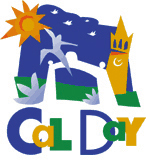 |
UC Berkeley will hold its annual open house, Cal Day, on Saturday, April 12 from 9 a.m. to 4 p.m.
The event is organized primarily for prospective students, although visitors of all ages can partake in hundreds of activities, such as tours of campus facilities (including classrooms and laboratories), lectures by faculty members, music, drama and art programs, athletic events, children's activities, and free entrance to many of the campus's renowned museums.
A central area featuring displays and information will be located in Dwinelle Plaza near Sather Gate and Wheeler Hall. Other information booths will be stationed around the campus.
The Lawrence Hall of Science Open will celebrate Cal Day with free admission. Featured exhibits include "Playing with Time" and "The Idea Lab." The International House will host a Spring Fest from 11 a.m. to 6 p.m., with performances, exhibits, and foods from around the world.
Campus buses will run from 7:30 a.m. to 4:30 p.m. around the perimeter of campus. In addition, a hill shuttle will take visitors to the Lawrence Hall of Science, the Botanical Garden, the Samuel L. Silver Space Sciences Laboratory, and Strawberry Canyon Recreation Area. The shuttle leaves every 30 minutes at the east entrance of Evans Hall.
For more information about Cal Day, see the UC Berkeley website at http://www.berkeley.edu/calday/.
The Health Services Department is offering its annual free skin screening clinic on Friday, April 25, from 8 a.m. to noon in Building 26. Dermatologist Elizabeth Ringrose and Health Services physicians will be available to screen employees for skin cancer and evaluate problematic skin lesions. All employees are invited to participate. To make an appointment call Health Services at X6266.
On Saturday, April 26, the Center for Research and Education on Aging (CREA) will present a public colloquium and health fair featuring talks, a discussion panel and demonstrations. The event will be held from 10 a.m. to 2 p.m. on campus (Valley Life Sciences Building, Room 2050).
Berkeley Lab along with UC Berkeley are among the sponsors of this event. Judith Campisi of Berkeley Lab’s Life Sciences Division will open the talks and participate in the panel discussion.
The fair will feature nutritional analyses, body fat and calcium measurements, Tai Chi and Qigong demonstrations, and resistance and strength training. The cost is $5 and includes refreshments.
This is the third annual colloquium and fair sponsored by CREA and is designed to provide exercise and nutrition tips and strategies for remaining healthy as we age. The event is supported by a grant from the National Institute on Aging of the National Institutes of Health.
CREA is a nonprofit collaborative program of UC Berkeley, Berkeley Lab, and Buck Institute for Age Research.
On Friday, April 11, the University of California will celebrate the achievements of Berkeley’s 18 Nobel Laurates by installing banners honoring them. Nine of them were Lab scientistis: Ernest Orlando Lawrence, Glenn T. Seaborg, Edwin M. McMillan, Owen Chamberlain, Emilio G. Segre, Donald A. Glaser, Melvin Calvin, Luis W. Alvarez, and Yuan T. Lee.
The unveiling ceremony will be held at 9 a.m. at Cody’s Books on Telegraph Avenue, and will be followed by a reception at the Berkeley Art Museum (2625 Durant Avenue). Please RSVP by April 9 at 643-5299.
The project is a collaboration of the Telegraph Business Improvement District and UC Berkeley Public Affairs.
 |
’01 JEEP WRANGLER SPORT, 60th anniv ltd edition, 5 sp, 35K mi, soft top, bra, premium sound, CD, silver/blk, $16,500/bo, Deborah, X5372
’00 MAZDA 626 ES, 32K mi, V-6, AT, prem sound, leather, sunrf, loaded, clean, under warranty, $10,950, Marylynn, (925) 938-2196
’98 MAZDA 626 LX, 98K mi, mt, ac, all pwr, alarm, am/fm/cd, tilt whl, cruise, sliding sunrf, alloy wheels, exc cond, clean, recent 95K major service, $6,300/ bo, Regina, (925) 422-6013 day / 595-1755 eve
’97 HONDA ODYSSEY, 87K, sunrf , tint windows, tow, alarm, alloy rims, ac, exc cond, $11,300, Steph-anie, (925) 944-5919
’92 TOYOTA COROLLA DX, beige, 4 dr sedan, 91K mi, at, ac, am/fm/cass, ps, tint glass, exc cond, new tires, $3,400/bo, Hongxing Dai, 524-4781 / 643-3535
’91 HONDA CIVIC DX, 4 dr, all pwr, 75k mi, reliable, economical, exc cond, $3,800/bo Dennis, X7859, (925) 933-7009
BERKELEY HILLS, bay view, furn rm, 17x15, own bth, priv entr, cooking facil in adj rm, w&d, pool table, workout mach, quiet neighbrhd near UC/pub trans/shops $850/mo incl linens, dishes, util, phone/ DSL, use of garden/bbq, bike storage/parking, no smoking/pets, avail after May 24, Carol, 524-6692
BERKELEY HILLS, 2 bdrm 1 bth, perfect for vis scholars, by wk/mo, quiet furn suite, sleeps up to 3, quiet, eleg, spacious, bay views, DSL, cable, microwave, walk to UCB, Denyse, 848-1830, dchew1@mindspring. com
BERKELEY HILLS, priv rm in 2 bdrm house, own bth, shared kitchen/liv rm, large closet, 10 min from LBNL, 1 bl from bus, lge yard, bay view, w/d, $1,200/ mo + util + dep, avail 4/03, Erika, 848-3328, 207-8275
BERKELEY, furn rm in 4 bdrm house, 5 blocks to campus/shuttle, nr rose garden, tennis courts, priv bth, kitchen & laundry facilities, $650/mo, avail now, Glenda, 548-1287
BERKELEY, furn rm avail now in House of International Scholars, rent incl util, laundry, cleaning, DSL access in rm, house computer, sat TV/VCR, $690/ mo, pictures/info @ http://housintscholar.hom.mindspring.com/ (Rm C), Anushka, 486-8153, housintscholar@mindspring.com
EL CERRITO, fully furn, 3 bdrm/2 bth home for rent 7/03 & 8/03, 9/03 an option, 20 min drive to Berkeley, nr bus, $1500/ mo, $500 dep, Art, 237-4654, a.tressler@worldnet.att.net
EL CERRITO, 2 bdrm/1 bth house for rent for 1 yr, avail 8/01, nr BART/pub trans & shops, $500/mo, dep $3,000, Jane, X2404
ELMWOOD, share 11 rm, 2 bth house w/ 2 professionals, 35+, nonsmoking, lge sunny bdrm w/ hill view, fp & big closet, avail 4/8, weekly shared dinners, yellow Lab, sauna, guest room, nice yards, $850/mo+dep, shared expenses, Tony, 841-4480
KENSINGTON, recently renov, fully furn 1 bdrm inlaw apt, linens/dishes/ cookware, incl local phone, TV &VCR, all util, laundry access, quiet, priv garden, view, non-smokers, $1400/mo, 1 mo min pref, Jan or Simon, 526-5294
NORTH BERKELEY, large 2 bdrm apt, washer, offstr parking, 10 min walk to BART/shopping, $1500/ mo, Louise, 526-5662
NORTH BERKELEY, furn lge sunny 1 bdrm apt, walk to campus /shuttle, all comfort, priv garden, gated carport, avail after 8/1, Geoffrey, gfchew@ mindspring.com, 848-1830
OAKLAND HILLS, large rm for rent in large house, share with 2 other active adults, sunny, views, walk-in closet, nr parks, open space, bus line, 15 min drive to lab, short term consid, Michelle, 531-9151
RICHMOND HILLS, adj Wildcat Canyon, freshly painted rm w/ view, share kitchen, nonsmoking, 3 prof adults, parking, $460/ mo, avail now, Tony, X7158, Diane, 232-7612
SOUTH LAKE TAHOE at Heavenly, vacation timeshare, 1 bdrm, deeded property, $3,000, Lynn, 614-7696
VISITING SCHOLAR w/ wife/4-year-old child seeks 1 bdrm apt in Berkeley/Albany/El Cerrito, nr public trans, nonsmoking, start 06/01, 10 mo or longer, Michael, X2913, MVTeplitsky@lbl.gov
DINNING TABLE, oval, lt color wood, w/ 4 chairs, $200/bo, Malak, 526-5495
LAWN TRACTOR w/ cart, 42” cutting craftsman 21.5 hp deck, auto trans, full pressure lubrication syst, dumping cart, 2 yr + rem warranty, $1,500, Ev, X4039
MOVING SALE, electric dryer, $175; microwave $20; twin bed w/ brass head/footboards, match comforter/sham/skirt/sheets$175; 2 antique rocking chairs, $25 ea; market umbrella w/ stand, $25; solid wood computer desk, $100; vert blinds for sliding glass doorway, $30; dishwasher, $150, Mary Ann, 528-4101
SMITH-CORONA, portbl man typewriter, good cond, $10; mahogany wood record cabinet in exc cond, $20, Ray, 525-2436
VINTAGE CLAWFOOT BATHTUB, 5’, good cond, missing one leg, $150/bo, Liz, X6179, 849-0275
WHITE DRESSERS, 6 drawer, 2 avail, diff styles, $25 ea; Packard Bell desktop computer w /monitor, 16 MB/200mhz/2.1 GB HD, $60/bo; 15" col monitor, $30/bo; oak roll top desk w/ compartments, 2 file drawers, sides fold, exc cond, $600/bo, Deborah, X5372, 317-7423
CAT, female spayed, indoors only, front claws removed, will provide vet checkup, Everett, X4039
NORTH LAKE TAHOE, cabin at Kings Beach, 3 bdr/2bth, sleeps 7+, minutes from Northstar, $135/day, 2 day min, $75 cleaning fee, Linda or Vlad, 849-1579
PARIS, FRANCE nr Eiffel Tower, furn eleg 2 bdrm apt, avail yr-round by week/mo, Geoff, 848-1830, gfchew@mindspring.com
TAHOE KEYS at S.Lake Tahoe, 3 bdrm house, 2-1/2 bth, fenced yard, quiet sunny, skiing nearby, great view, $195/night, 2 night min, Bob, (925) 376-2211 or rrs@value.net
Ads are accepted only from LBNL employees, retirees, and onsite DOE personnel. Only items of your own personal property may be offered for sale.
Submissions must include name, affiliation, extension, and home phone. Ads must be submitted in writing (e-mail: fleamarket@lbl.gov, fax: X6641, or mailed/delivered to Bldg. 65).
Ads run one issue only unless resubmitted, and are repeated only as space permits.
The deadline for the April 18 issue is Thursday, April 10.
Users of Windows NT, 2000 or XP systems that run the Internet Information Server (IIS), are invited to a free course on IIS security on Monday, April 21, from 9 a.m. to 5 p.m. in the Building 50 auditorium.
Gene Schultz of the Computer Protection Program will be the instructor. To enroll see https://hris.lbl.gov/. Enrollment is on a first-come, first-served basis.
Ted Sopher, LBLnet Services group manager, will be the speaker at the April 15 Computer Protection Brown Bag. His talk will look at what is being done at the Lab to secure wireless networks.
The presentation will be held at noon in the Building 50 auditorium.
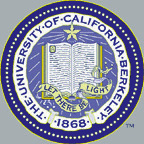 |
Gabor A. Somorjai of Berkeley Lab’s Materials Sciences Division and a professor of chemistry at UC Berkeley is a presenter in the University's 90th Faculty Research Lectures. His April 9 talk will address “Surfaces: Favorite Media of Evolution and New Technologies.” The lecture will be held at 5 p.m. in the Wheeler Auditorium on campus.
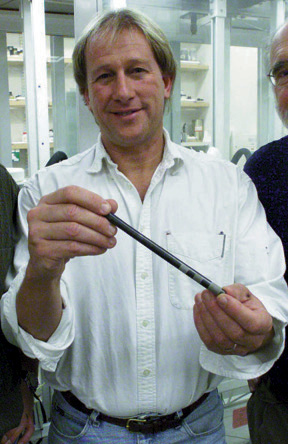 |
Steven J. Visco of the Materials Sciences Division will be the speaker at the next presentation of Friends of Science, to be held on Thursday, April 10 from 5:30 to 7 p.m. in Perseverance Hall.
Berkeley Lab researchers have developed a solid oxide fuel cell that promises to generate electricity as cheaply as the most efficient gas turbine. This innovation lies in replacing ceramic electrodes with stainless-steel-supported electrodes. These are stronger and easier to manufacture, and cheaper than the devices in use today. The new technology paves the way for pollution-free power generators that would serve neighborhoods and industrial sites.
Reservations are required. Please send an email to friendsofscience@lbl.gov or contact the Community Relations Office at X7292. Reserved parking will be available after 5 p.m. in the Building 54 lot.
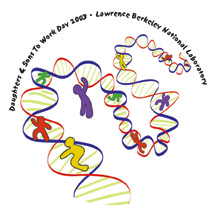 |
For the tenth consecutive year, Berkeley Lab will host Take Our Daughters and Sons to Work Day (DSTW) — a day of science and fun for young guests of Lab employees (girls and boys aged 9 to 16). This year’s event will be held on Thursday, April 24. Space is limited to 240 children.
The program consists of morning and afternoon workshops, opening assembly, lunch, and an ice cream social. Workshops and activities will include glass blowing, liquid nitrogen, medical imaging, DNA spooling, and firehouse activities.
To register, download a form from the DSTW website (in the A-Z index on the Lab’s home page) and mail it by April 10, along with a check of $12 per child, to DSTW, CSEE, MS 7RO222. Checks should be made payable to “UC Regents.” Workshop assignments are made on a first-come, first-served basis.
For more information or additional registration forms,
contact Joe Crippen in CSEE at X5816, JRCrippen@lbl.gov,
or see http://www.lbl.gov/Education/CSEE/dstw/2003schedule.html.